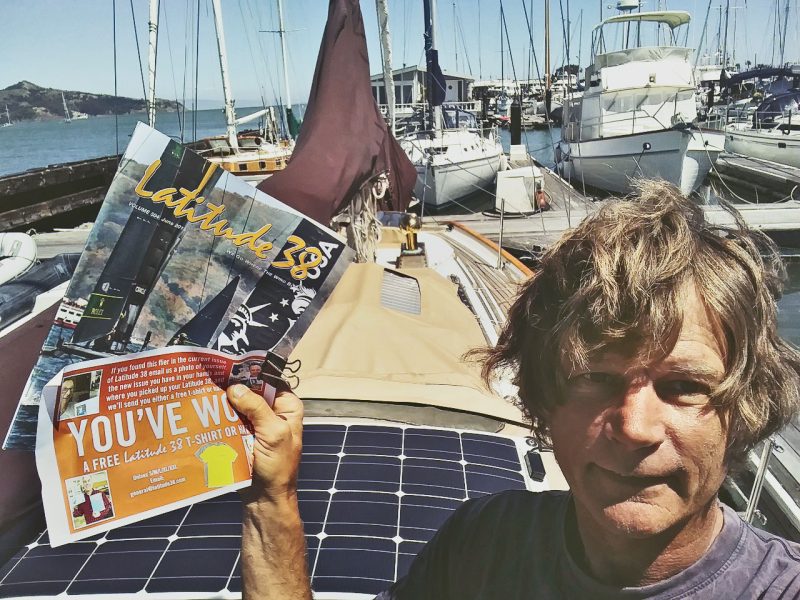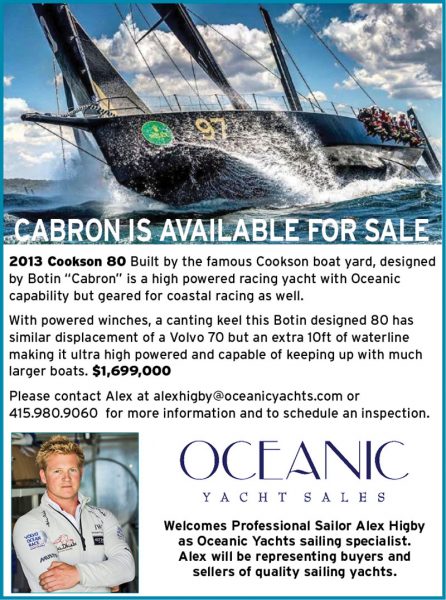
The Sinking of Wander Bird
We were shocked to receive the news that the German pilot schooner Elbe No. 5 — which several generations of Bay Area sailors will know best as ‘our’ lovely Wander Bird — sank on Saturday after a collision with a commercial ship on the Elbe River near Hamburg. The incident occurred shortly after noon when the recently restored and relaunched 85-ft LOD schooner, with 43 passengers aboard, somehow ended up directly in the path of the 465-ft container carrier Astrosprinter.
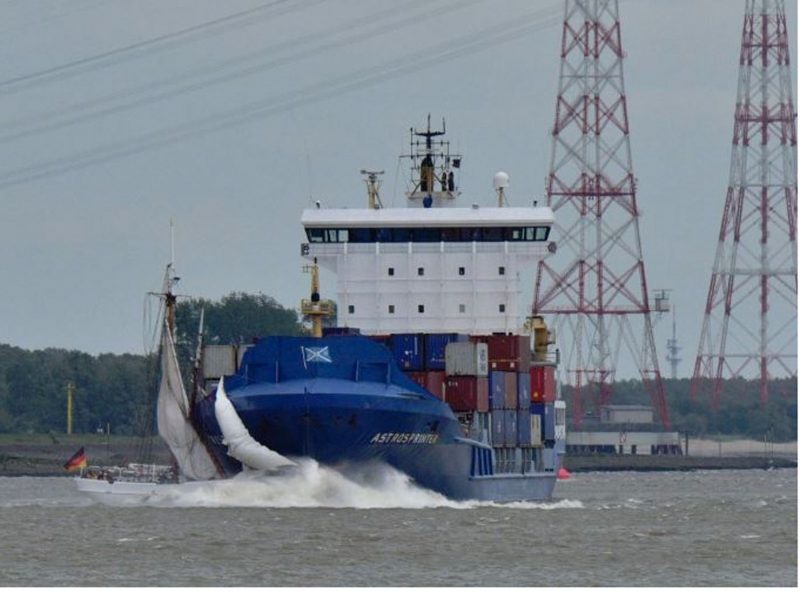
Early reports differ as to the cause of the accident. One report notes a ‘failed tack’; another that the Cyprus-flagged Astrosprinter was “out of its shipping lane.” Maritime law puts the burden on smaller vessels to keep clear of large ones, but we don’t know if the rules of the road are different in Germany (or the Elbe), how fast each vessel was going, or, ultimately, which one was at fault. Investigations are underway and we’ll post more information on ‘Lectronic Latitude as we get it.
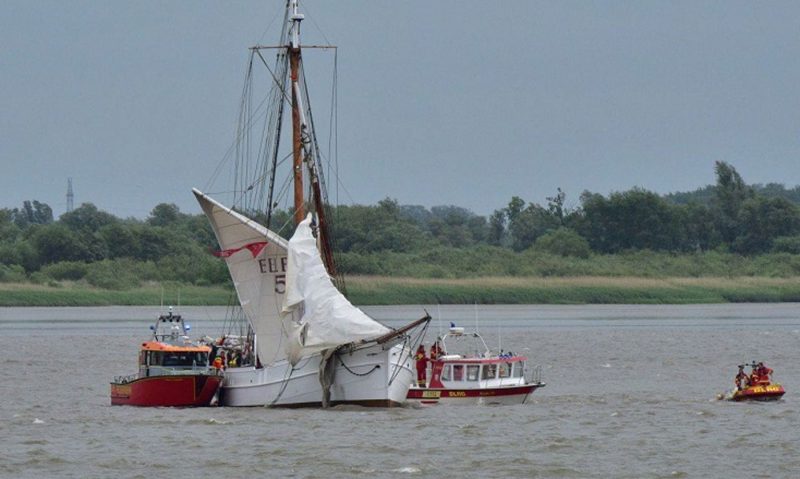
In a stroke of luck, several motor rescue boats from the DLRG (the German Coast Guard) were attending another incident nearby and sped to the scene. Everyone aboard Elbe 5 was rescued, with five to seven injuries reported, including one serious injury to someone apparently hit by the toppled foremast.
The Astrosprinter was not damaged and eventually resumed its outbound journey.
The extent of damage to Elbe 5 is unclear, but she did not sink immediately. Emergency pumps were brought aboard, and, along with the tall ship’s own pumps, they were able to keep her afloat long enough to for her to reach shallower water. The ship finally went down in what appears to be shallow water next to a wharf in the harbor at Stadersand. Most of the rig remains above the surface. The area above the ship is currently boomed off to contain leaking fuel while the owners, the Hamburg Maritime Foundation, decide what to do next.
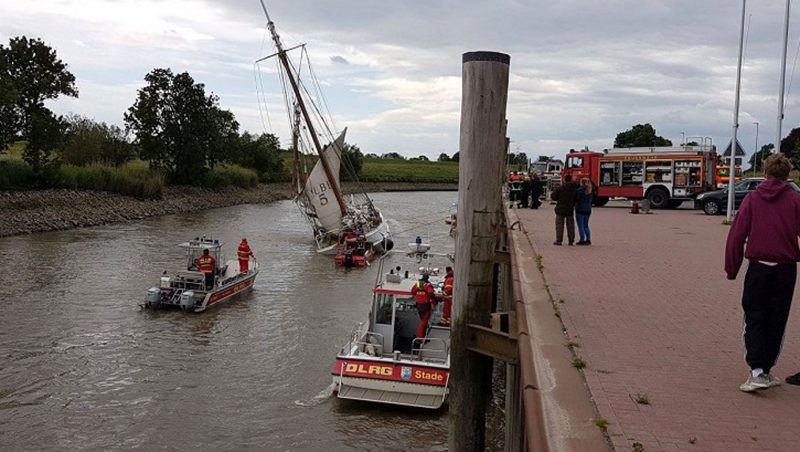
Elbe 5 was built in Hamburg in the early 1880s, and launched in 1883. She served 41 years as a pilot boat ferrying pilots to and from ships in the North Sea. Steamers eventually replaced the old schooners, and over the next few years the ship — at some point renamed Wandervogel — went through a series of owners, ignorance, incompetence and neglect.
The adventures that made the ship an integral and beloved part of the San Francisco sailing scene began in 1929 when she was bought – cheap – by author/adventurer Warwick Tompkins Sr. The ‘translated’ Wander Bird arrived in San Francisco Bay in 1937 after a voyage around the Horn. Among those aboard were Tompkins’ 4-year-old son, Warwick ‘Commodore’ Tompkins Jr., who would go on in adulthood to become one of the premier racing sailors in the world.
Wander Bird ended up in Sausalito, where she would be homeported for the next six decades. The ship was eventually acquired by Harold Sommer in the late ‘60s and underwent an extensive restoration by a cast of waterfront characters and legends, including Spike Africa, John Linderman and actor/sailor/author Sterling Hayden. (In the 1990s that project was deemed by the Smithsonian Museum to be the most significant vessel restoration done by a private individual in the US.)
Wander Bird didn’t sail that often — partly because it took a small army of people to crew the ship — but it was always a thrill to see the schooner when Harold did take took her out, occasionally to race in a Master Mariners Regatta.
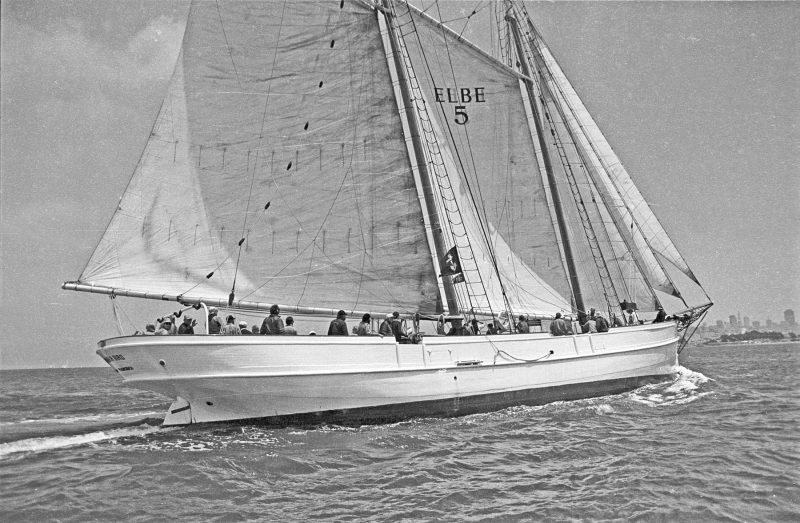
The ship’s tenure in the Bay Area ended in the mid-’90s, when a couple of art dealers in Seattle bought her. Long story short, their big plans for the ship never materialized, and Wander Bird started to deteriorate once again. Then, in 2002, the Hamburg Maritime Foundation acquired the old ship and had her returned to her home waters of Hamburg on the deck of a freighter. After some restoration work, it wasn’t long before she was taking tourists on tours of Hamburg’s harbor.
Last year, the ship went up on the ways at a Danish yard for her most extensive and expensive restoration yet. The nine-month, $1.7 million project was completed only last month. (Commodore, now 87, and his wife Nancy, were invited over for a VIP tour of the ship toward the end of that project.) The ship had only returned to Hamburg at the end of May to resume tourist sails.
As bad as this incident is, it could have been worse. Most importantly, there was no loss of life. Secondly, because of the quick action of the crew and German rescue teams, the ship is currently in about the best place possible for a salvage attempt. We hope we’re speaking for the entire Bay Area sailing community when we say we fervently hope that will happen.
We’ll keep you posted.
Electric Foilboarding Is Now a Thing
We once saw a man walk on water.
We were sailing back home to Lowrie in San Rafael after a long, splendid day on the Bay. As we close-reached up the channel, we saw a man . . . surfing without a wave, sail or kite. If we hadn’t been keeping up on watersports trends, we may very well have thought that someone was riding a magic carpet, or walking on water. It was, of course, an electric foil board, where a small motor on the foil provides autonomous thrust.
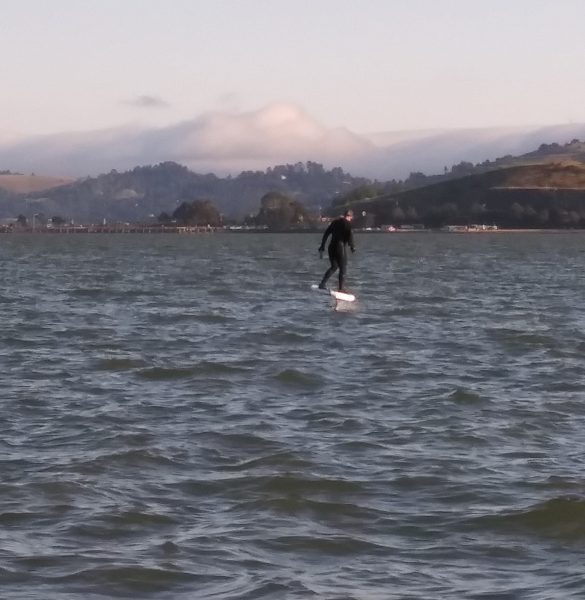
Immediately, we pondered the existential implications of the proliferation of such craft. First thought: Damn, we want to ride one of those! (Once ashore, we Googled to check the cost . . . They’re tens-of thousands-of dollars, so, yeah, forget about that for a while.)
Second thought: If electric foilboards become relatively affordable — like wind- or kitesurfers — will the Bay be swarming with them one day? We could not help but conjure flocks of silent boards skimming the water.
Just as with drones, new technologies spawn conversations about new responsibilities. If everyone can soon jump onto their own version of a magic carpet, then, to some extent, seamanship and etiquette will obviously have to evolve with the craft on the water. And just as with wind- and kitesurfers, we’re sure that some people were less than excited to see new, fast craft all over the water. (Recently, the Coast Guard issued a statement asking kiters to be more careful in the wake of a boom in rescues.)
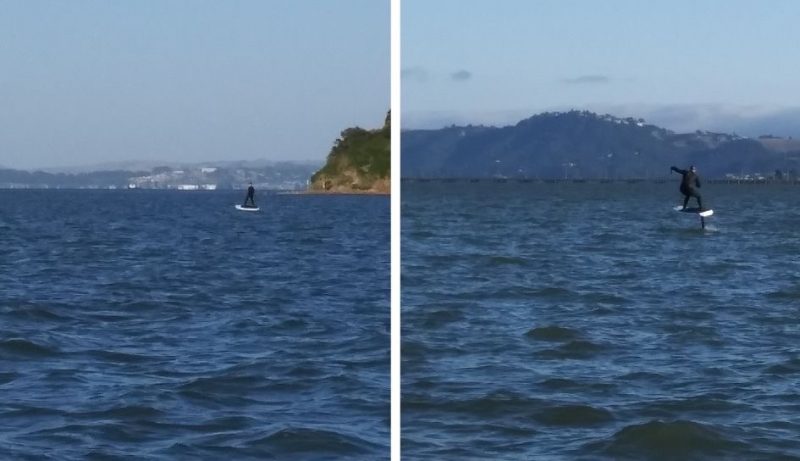
The libertarian in us wants to say, “Relax, it’ll be fine. People’s responsibility and better judgment will be forced to prevail.” The slightly salty, curmudgeonly worry-warts in us say, “We are so screwed if we’re relying on people’s responsibility and better judgment.”
Anyway, we want to know what you think about this particular trend. Do you shudder to think what the future might bring? Are you excited for what’s next? Can you not wait to try one of these things? Do you have one and you, like, totally want to share it with us? Please, comment below, or write us here, and if applicable, please include your boat name, make and port of call.
For a quick review of electric foilboarding here’s a youtube video we found:
Oceanic Yacht Sales
The Birds
We were out of Cabo San Lucas headed for Puerto Vallarta when a frigatebird came swooping in, circling, circling, gliding in a steep left bank until its wingtip nearly touched the ocean, the top of its wings black, glistening in the late afternoon sun. Now climbing, climbing higher than our mast, into the wind, higher, higher, left bank, now downwind picking up speed, faster, faster. Around and around our little sailboat. Pretty. Serene.
After a while, it was joined by another bird, then another, and soon there were four flying in ragged formation, gull wings, long pointy beak. Evil, wicked, mean and nasty. One broke formation, increased its bank and headed for our mast, and landed on our spreader. Soon, it was joined by the others. What are the frigate birds doing on our spreader? Oh shit!
Now our captain, like most captains, has a place for everything and everything in its place and bird poop has no place on his boat. Here begins the somewhat disturbing tale of the bird poop incident.
Have you ever wondered what sea gulls eat? Me neither. Too much information. Well, now I have a pretty good idea. Birds eat stinky stuff. Fish guts, squid guts, bird guts — doesn’t matter, if it stinks, they’ll eat it. When not eating stinky stuff, what do birds do? Poop. Poop stinky stuff; just like it was when it went in, only stinkier. Stinky, white frigatebird poop, all over the captain’s deck.
As all mariners know, bird poop is the most caustic, tenacious, indestructible substance known to man. Seagull poop has been known to eat through gel coat, clear coat, top coat, fiberglass and stainless steel. A fishing boat out of Bodega Bay once didn’t clean the transom after a particularly unsuccessful fishing trip and the next morning was found sunk in six feet of mud. The boat is still there, you can see for yourself.
We tried everything we could think of to get the birds off the spreader In order: banging on the shrouds with the boat hook, whipping a spare halyard at the spreader, squirting with the raw- water hose (not enough pressure), slingshot made from bungee cords (range three feet). Nothing worked.
In desperation, the captain yelled, “You frigatebirds, get off my boat!” Only it came out more like, “You freakin’ birds, get off my freakin’ boat!” Surprisingly, one of the birds left. We were inspired by this. “What makes noise? The air horn!” This kept us busy until the air horn ran out of air.

We’d been somewhat successful with the air horn, so only two birds remained on the spreader. The captain had another idea. “What if we tack? The mainsail should scare ‘em off the spreader.” It worked! Midnight came, end of my watch and time for the sack.
Around 2 a.m., the captain called me on deck, the wind had died, and we needed to drop the main. My job was to watch and assist if anything went wrong. All went well, some cold tea and a snack and I was off to the V-berth. The forward hatch was open, and I could dimly see something hanging down inside the hatch. I thought, “Must be a jib sheet has fouled.” I reached up through the hatch to remove the sheet and grabbed a handful of tail feathers! Oh shit!
Back up on deck: “Captain! There is a friggin’ bird on the forward hatch!”
“That’s it!” cried the captain, “Where is my boat hook?”
Now this captain’s fondness for boat hooks goes way back. Need replacement batten? Boat hook. Broken spinnaker pole? Boat hook. Need an emergency tiller? Boat hook. Sheared mast? Boat hook. There wasn’t anything onboard that couldn’t be repaired with a boat hook and some duct tape.
Gripping the boat hook like a sword, the captain yelled, “En guarde!” and lunged at the bird. The bird parried with its beak. The captain now realized his advantage was weight. The bird defiantly held fast to the boat hook. The captain, in an amazing display of mixed martial arts skill, gently picked up the bird and shook it loose over the side. “Ploop!” Problem solved.
This is amusing but I really need some sleep. Back to the V-berth, I sat on the edge of the bunk and thought, “What was the friggin’ bird doing on the forward hatch? Oh shit! I felt something wet on the mattress, turned on the light and saw a pancake-size puddle of freakin’ bird poop!
I was back on watch at 0600 and had to get some sleep. I looked around — a bucket, equal parts of Lysol, Clorox and Diesel fuel (to kill the smell) and my bunk and pillow were good to go.
Back in the sack, I remembered that I’d sat in freakin’ bird poop. Bunk’s good, what about me? Lights on, shorts off, sure enough, freakin’ bird poop on my shorts. Now what? Starboard watch navy shower — a damp paper towel — I should be good to go. But this is freakin’ bird poop, nasty stuff. Is the paper towel enough? Then I noticed a bottle of hand sanitizer hanging on the bulkhead. Perfect.
I wonder if Purell would give me royalties for a new product idea. We’ll call it butt sanitizer.
I Won!
Congratulations to two winners of Latitude 38 swag. Stephen Buckingham picked up a copy of the June issue at South Beach Yacht Club at San Francisco’s Pier 40 on May 31. He’d been crewing in the club’s Friday night race, tending the bow — an athletic endeavor even in mild weather — aboard the J/105 Big Buoys. “It blew 34 knots!” he said.
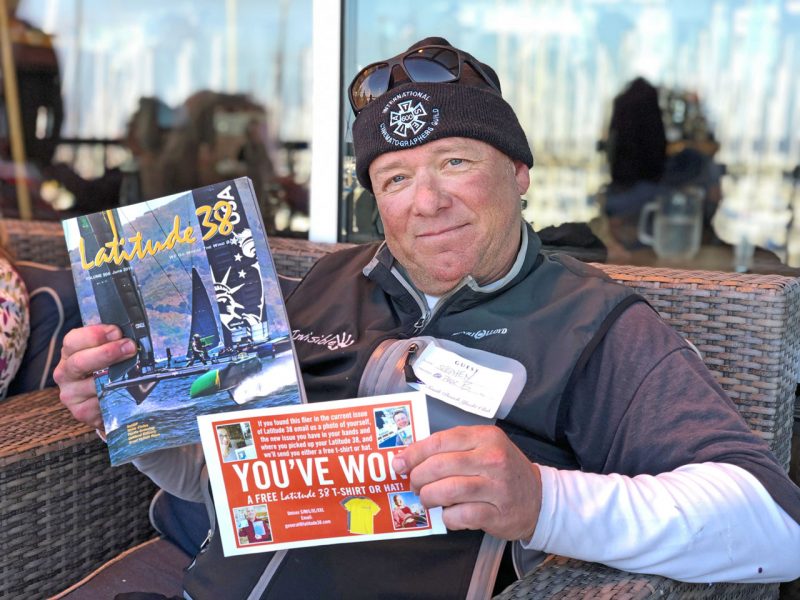
Charles Bohlen picked up his Latitude at Duke’s Chandlery in Sausalito. “I have been a reader since 1978. I learned from Lois at Cass’ Marina, and the rest is sailing history!”
